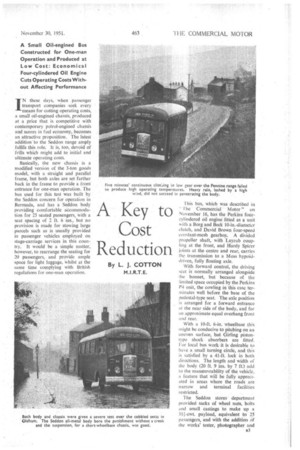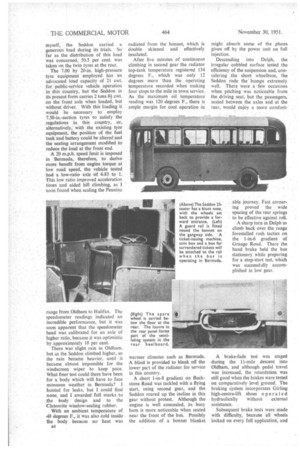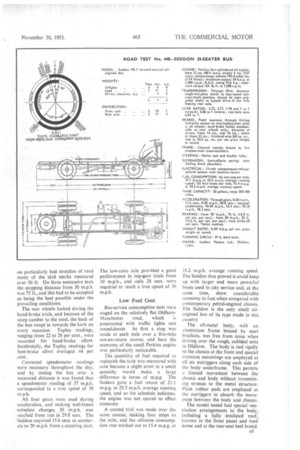A Key to Cost Reduction
Page 37

Page 38

Page 39

If you've noticed an error in this article please click here to report it so we can fix it.
By L. J. COTTON m.I.R.T.E. IN these days, when passenger transport companies .seek every means for cutting operating costs, a small oil-engined chassis, produced at a price that is competitive with contemporary petrol-engined chassis and scores in fuel economy, becomes an attractive proposition. The latest addition to the Seddon range amply fulfils this role, it is, too, devoid of frills which might add to initial and ultimate operating costs.
Basically, the new chassis is a modified version of the 3-ton goods model, with a straight and parallel frame, but both axles are set farther back in the frame to provide a front entrance for one-man operation. The bus used for this test was built by the Seddon concern for operation in Bermuda, and has a Seddon body providing comfortable aCcommodation for 25 seated passengers, with a seat spacing of 2 ft. 6 ins., but no provision is made for stowing large parcels such as is usually provided in passenger vehicles employed on stage-carriage services in this country. It would be a simple matter, however, to rearrange the seating for 20 passengers, and provide ample space for light luggage, 'whilst at the same time complying with British regulations for one-man operation. This bus, which was described in ale Commercial Motor" on November 16, has the Perkins foureylindered oil engine fitted as a unit with a Berg and Beck 10-in.-diameter clutch, and David Brown four-speed constant-mesh gearbox. A divided propeller shaft, with Layrub coupling at the front, and Hardy Spicesjoints at the centre and rear, carries the transmission to a Moss hypoiddriven, fully floating axle.
With forward control, the driving seat is normally arranged alongside the bonnet, but because of the limited space occupied by the Perkins P4 unit, the cowling in this case terminates well before the base of the pedestal-type seat. The axle position is arranged for a forward entrance at the near side of the body, and for an approximate equal overhang front and rear.
With a 10,ft. 6-in, wheelbase this !night be conducive to pitching on an uneven surface, but Giding pistontype shock absorbers are fitted. For local bus work, it is desirable to have a small turning circle, and this is satisfied by a 41-ft. lock in both directions. The length and width of the body (20 ft. 9 ins. by 7 ft) add to the manceuvrability of the vehicle, a feature that will be fully appreciated in areas where the roads are narrow and terminal facilities restricted.
The Seddon stores department provided sacks of wheel nuts, bolts and small castings to make up a 311-ewt payload, equivalent to 25 passengers, and with the addition Of the works' tester; photographer and
myself, the Seddon carried a generous load during its trials. So far as the distribution of this load was concerned, 50.5 per cent. was taken on the twin tyres at the rear.
The 7.00 by 20-in, high-pressure tyre equipment employed has an advocated load capacity of 21 cwt. for public-service vehicle operation in this country, but the Seddon in its present form carries 2 tons 81cwt. on the front axle when loaded, but without driver. With this loading it would be necessary to employ 7.50-in.-section tyres to satisfy the regulations in this country, or, alternatively, with the existing tyre equipment, the position of the fuel tank and battery could be altered and the seating arrangement modified to reduce the load at the front end.
A 20 m.p.h. speed limit is imposed in Bermuda, therefore, to derive more benefit from engine torque at low road speed, the vehicle tested had a low-ratio axle of 6.83 to 1. This low ratio improved acceleration times and aided hill climbing, as soon found when scaling the Pennine range from Oldham to Halifax. The speedometer readings indicated an incredible performance, but it was soon apparent that the speedometer head was calibrated for an axle of higher ratio, because it was optimistic by approximately 18 per cent.
There was slight rain in Oldham. but as the Seddon climbed higher, so the rain became heavier, until it became almost impossible for the windscreen wiper to keep pace. What finer test could there have been for a body which will have to face monsoon weather in Bermuda? I hunted for leaks, but I could find none, and I awarded full marks to the body design and to the Clatonrite window-sealing rubber.
With an ambient temperature of 48 degrees F., it was also cold inside the body because no heat was radiated from the bonnet, which is double skinned and effectively insulated.
After five minutes of continuous climbing in second gear the radiator top-tank temperature registered 134 degrees F., which was only 12 degrees more than the operating temperature recorded when making four stops to the mile in town service. As the maximum oil temperature reading was 120 degrees F., there is ample margin for cool operation in warmer climates such as Bermuda. A blind is provided to blank off the lower part of the radiator for service in this country.
A short 1-in-8 gradient on Buckstone Road was tackled with a flying start, using second gear, and the Seddon roared up the incline in this gear without protest. Although the engine is well concealed, its busy hum is more noticeable when seated near the front of the bus. Possibly the addition of a bonnet blanket might absorb some of the phons given off by the power unit on full injection.
Descending into Del ph, the irregular cobbled surface tested the efficiency of the suspension and, considering the short wheelbase, the Seddon rode the bumps extremely well. There were a few occasions when pitching was noticeable from the ,driving seat, but the passengers, seated between the axles and at the rear, would enjoy a more comfort able journey. Fast cornering proved the wide spacing of the rear springs to be effective against roil.
A sharp turn in Delph to climb back over the range forestalled rush tactics on the 1-in-6 gradient of Grange Road. There the hand brake held the bus stationary while preparing for a stop-start test, which was successfully accomplished in low gear.
A brake-fade test was staged during the descent into Oldham, and although pedal travel was increased, the retardation was still good when the brakes were tested on comparatively level ground. The braking system incorporates Girling high-centre-lift shoes opera t ad hydraulically without external assistance.
Subsequent brake tests were made with difficulty, because all wheels locked on every full application, and
on particularly bad stretches of road many of the skid • marks measured over SO ft. On three successive tests the stopping distance from 30 M.p.h. was 75 ft., and this had to be accepted as being the best possible under the prevailing conditions. The rear wheels locked during the hand-brake trials, and because of the steep camber to the road, the back -of the bus swept in towards the kerb on every occasion: Tapley readings, ranging from 22 to 28 per cent., were recorded for hand-brake effort. Incidentally, the Tapley readings for foot-brake effort averaged 44 per
cent. • Corrected speedometer readings were necessary throughout the day, and by timing the bus over a measured distance it was found that a speedometer reading of 37 m.p.h. corresponded to a true speed of 30 m.p.h.
All four gears were used during acceleration, and making well-timed noiseless changes 30 m.p.h._ was reached from rest in 2.9.8 secs. The Seddon required 15.6 secs. to accelerate to 20 m.p.h. from a standing start.
The low-ratio axle provided a good performance in top-gear trials from 10 mph., and only 28 secs. were required to reach a true speed of 30
Low Fuel Cost
Bus-service consumption tests were staged on the relatively flat OldhamManchester road, which is punctuated with traffic lights and roundabouts At first a stop was made at each mile over a five-mile out-an-return course, and here the economy of the small Perkins engine was particularly noticeable.
The quantitiy of fuel required to replenish the tank was measured with care because a slight error-in a small quantity would make a large difference in terms of m.p.g. The Seddon gave a fuel return of 21.1 m.p.g. at 23.5 m.p.h. average running speed, and as the schedule indicates, the engine was not spared to effect economy.
A second trial was made over the same course, Making four Stops to the mile, and the ultimate consumption rate worked out to 15.4 m.p.g. at 18.2 m.p.h. average running speed. The Seddon thus proved it could keep up with larger and more powerful buses used in city service and, at the same time, show considerable economy in fuel when compared with contemporary petrol-engined chassis. The Seddon is the only small oilengined bus of its type made in this country
The all-metal body, with an aluminium frame braced by steel brackets, was free from noise when driving over the rough, cobbled setts in Oldham. The body is tied rigidly to the chassis at the front and special trunnion mountings are employed at all six outriggers along each side of the body underframe. This perinits a limited movement between the chassis and body without transmitting stresses to the metal structure. Plain rubber pads are employed at the outriggers to absorb the movement between the body and chassis.
The model tested had special ventilation arrangements to the body, including a fully insulated roof, louvres in the front panel and roof dome and at the rear-seat heel board.




















































































